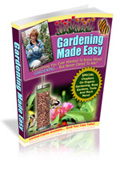Welcome to Gardening Guide
Gardening Indoor Plant Article
 . For a permanent link to this article, or to bookmark it for further reading, click here.
. For a permanent link to this article, or to bookmark it for further reading, click here.
INDOOR GARDENING WATERING SYSTEMS
from:Indoor gardening watering systems determine how much water you give your houseplants, and how often. There are different indoor gardening watering systems for different types of plants. You must also take into consideration such things as the temperature and humidity of the room the plant is in and even the type of pot the plant is in.
Plants require plenty of water if they are actively growing, have thin and delicate looking leaves, are in a very warm room, have many large leaves, have a mass of large and healthy roots, are in relatively small pots, are in dry air, are from bogs or marshes, are in clay pots, or have budding leaves and blossoms.
Plants need less water if they are resting or without buds or flowers, have thick leathery leaves, are in a cool room, have recently been re-potted, are in a humid room, are in a water-retentive potting mixture, are in plastic or glazed clay pots, have thick and fleshy roots, or are naturally adapted to storing water for long periods of time (cacti).
Indoor gardening watering systems have three basic methods of applying water. With top watering you pour water onto the surface of the potting mixture. This gives you better control of the amount of water the plant receives. It also flushes away accumulated excess mineral salts. With watering from below, you pour the water into the saucer in which the pot sits. This method forces mineral salts to the upper layer of the potting mixture. You can flush them away with occasional top watering. With large open plants, use bromeliad watering, which means using a narrow spouted watering can to pour the water directly into the “cup” at the centre of the plant.
You can usually use ordinary tap water for indoor gardening watering systems, but it must be tepid, not cold. Allow the water to stand overnight in a container so it reaches room temperature. This will also allow some of the chlorine to dissipate. If the water has a high lime content, boil it first. Do not use water from a water softener, as the chemicals will damage your plants. Rainwater is good in rural areas, but rainwater in urban areas is often polluted. Distilled water is lime free, if you want to go to that expense.
Indoor gardening watering systems require you to use water sparingly, moderately or plentifully, depending upon the type of plant and the plant’s environment and stage of growth. If you water sparingly, barely moisten the potting mixture. If you water moderately, moisten the mixture all the way through, but allow the top layer to dry out between applications. If you water plentifully, keep all of the mixture moist, including the top layer.
Gardening Indoor Plant News



